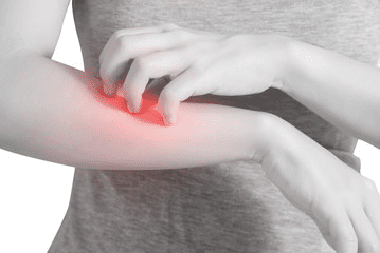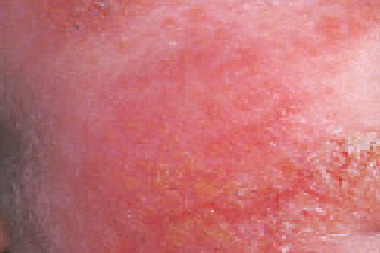Dermatology >>>> Causes of atopic dermatitis and its prevention
Causes of atopic dermatitis and its prevention.

To understand how to prevent the development of a disease such as atopic dermatitis, it is necessary to investigate the factors that provoke its occurrence. Atopic dermatitis is a chronic inflammation of the skin accompanied by itching. This disease is polymorphic (diverse) in its external manifestations on the skin, therefore, it is often given other names (atopic eczema, neurodermatitis).
To date, the scientific medical community is of the opinion that two types of factors give a significant impetus to the onset of atopic dermatitis: the genetic predisposition of the body and the body's response to various kinds of allergens (the most important of which is given to food allergens). But there are a number of factors, the role of which is also taken into account.
These factors include:
- Patient skin infections (eg, skin colonization by Staphilococcus aureus)
- Climatic living conditions
- Aeroallergens (house dust mites, pollen, household aerosols)
- rritants (specialized tear or irritant aerosols)
- Chronic stress (worsens itchy skin)
- Hygiene
The body's genetic predisposition to the onset of atopic dermatitis is based on:
- genetic predisposition to allergic reactions - a violation in the work of immune processes: increased formation of immunoglobulins of the IgE class, a violation of the synthesis of interleukins IL4, a genetically programmed immune response of the Th2 type (when cells begin to produce a group of interleukins that cause an acute inflammatory process);
- due to heredity, excessive accumulation of Langerhans cells (intraepidermal macrophages capable of migration and phagocytosis) and dendritic cells (all these types of cells are associated with IgE immunoglobulins) in the skin, impaired lipid synthesis and, as a consequence, increased dryness of the skin and a violation of its barrier properties.

Statistical data on a hereditary predisposition to atopic dermatitis indicate that in the case when both parents are prone to allergies, the risk of developing atopic dermatitis in a child is 60 - 80%, when one of the parents is allergic - 40 - 50%. But there are statistics that reflect data on healthy parents who gave birth to a child suffering from atopic dermatitis>. This suggests that the reasons for the development of atopy are not fully understood.
Immune reactions to various allergens:
The ingestion of an allergen into the body of a person prone to atopy triggers the mechanism of an inflammatory immune response, when cells that produce cytokines and IgE immunoglobulins accumulate in a certain place (focus of inflammation) . With the elimination of the allergen, the process does not stop, but becomes stable.
Allergic reactions that cause atopic dermatitis have a variety of causes:
- food allergies,
- dust allergy,
- pollen allergy,
- allergy to wool and animal dander
Prevention of atopic dermatitis and its exacerbations.
Preventive measures to prevent the development of atopic dermatitis are directly related to the causes of its occurrence. But if the genetic predisposition cannot be bypassed, then taking into account all other factors, you can reduce the risk of developing atopic dermatitis.
Since the disease most often occurs in the first months or years of a child's life, the expectant mother, before and during pregnancy, should change her lifestyle and diet.
To exclude from the diet low-quality food products (dubious production and recipes), products containing preservatives and various additives such as dyes, hardeners, sweeteners of synthetic origin.
Eat fruits and vegetables without the skin, as it is treated with various substances for long-term preservation of the fruit. Avoid the use of plant products containing genetically modified plants, be interested in the place and mechanism of cultivation of plant products (that is, use fruits, vegetables, herbs for food, grown without the use of growth stimulants and maturation catalysts).
Get rid of bad habits (smoking and alcohol).
Improve the climatic zone of residence.
Carefully select cosmetics for care and make-up, they are usually rarely natural.
After the baby is born, the first thing to consider is breastfeeding. It should not be abandoned, since breast milk is a very important stage in building the immune defense system of a newborn baby. This is the most significant thing a mother can do for her baby to strengthen her future immunity.
An early transition to complementary feeding leads to the fact that potentially allergenic products can get into the baby's food, and no one is immune from this, since it is not possible to trace the sources of the ingredients for baby food to the consumer. Thus, the longer the period of breastfeeding, the longer the delay in the development of atopic dermatitis in a child with a predisposition to it.
The situation is more complicated with “involuntarily” artificial people, when the mother does not have milk. In this case, parents should carefully select baby food, critically examining any products for the baby. It is advisable to focus on hypoallergenic dietary products.
From the moment the child switches to the usual "adult" food, it is necessary to adhere to a diet that excludes foods that contribute to the increased formation of IgE immunoglobulin. In total, according to statistics, about 170 types of food can initiate an allergic IgE-mediated reaction, but the largest share of food allergies is caused by several foods:
- Nuts (peanuts, brazil nuts and others),
- Eggs,
- Milk products,
- Wheat,
- Legumes (soybeans, beans),
- Fish and seafood (lobster, crabs, shrimp, shellfish).
Create conditions in the apartment that exclude the accumulation of dust:
- Less carpets, fluffy furniture, large stuffed animals,
- Hide a large number of books in glass cabinets,
- Curtains should be natural, as synthetics are electrified and attract dust,
- TVs and computers tend to attract dust and need to be looked after more often.
Clothing requires special attention as it can irritate the skin. Things made of wool should be excluded from the wardrobe, the emphasis should be on cotton, natural silk and non-fleecy acrylic. "Cool" synthetics also cause irritation and will not let the skin "breathe".
Pets in the home can become a source of allergies, so it is worth thinking carefully before adopting a pet. Having got used to your pet, it will be difficult for you to refuse it.
All these simple methods will help not to provoke allergic reactions once again, which means that they will delay the start of the mechanism for the development of atopic dermatitis.

Read

Read


























